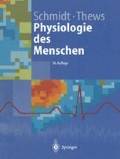Zusammenfassung
In unserer Alltagssprache steht Blut fürTemperament des Lebens — blutjung, heißblütig — wie auch für die Gefahr seines Verlustes — blutarm, ausgeblutet. Mit Recht hat das Blut seine metaphorische Rolle in Religionen, Literatur und Volksmund. Seine Bestandteile sichern die Lebensfähigkeit aller anderen Körperzellen, und sie schützen den Organismus vor Krankheitserregern.
Access this chapter
Tax calculation will be finalised at checkout
Purchases are for personal use only
Preview
Unable to display preview. Download preview PDF.
Literatur
Weiterführende Lehr- und Handbücher
Barthels M, Poliwoda H (1993) Gerinnungsanalysen, 4. Aufl. Thieme, Stuttgart
Begemann H, Rastetter J (Hrsg) (1993) Klinische Hämatologie, 4. Auflage. Thieme, Stuttgart
Bell G, Davidson JN, Scarborough H (eds) (1965) Textbook of physiology and biochemistry. Livingstone, Edinburgh
Bessis M (1974) Corpuscles. Atlas of red blood cells. Springer, Berlin Heidelberg New York
Chapel H, Haeney M (eds) (1993) Essentials of clinical immunology, 3rd edn. Blackwell Scientific, Oxford
Fisher JW (ed) (1992) Biochemical pharmacology of blood and bloodforming organs. Springer, Berlin Heidelberg New York (Handbook of experimental pharmacology, vol ioi)
Gamble JL (1954) Chemical anatomy, physiology and pathology of extracellular fluid, 6. Aufl. Harvard University Press, Cambridge, Massachusetts
Guyton AC (ed) (1990) Textbook of medical physiology, 8th edn. Saunders, Philadelphia
Hoffbrand AV, Pettit JE (Hrsg) (1989) Klinische Hämatologie. Sandoz Atlas. Gower Medical, London/Sandoz, Basel
Hofman R, Benz EJ, Shattil SJ, Turei B, Cohen HJ (eds) (1991) Hematology. Basic principles and practice. Churchill Livingston, New York
Jaenecke J (Hrsg) (1991) Antikoagulantien-und Fibrinolysetherapie, 4. Aufl. Thieme, Stuttgart
Keidel WD (Hrsg) (1993) Kurzgefaßtes Lehrbuch der Physiologie, 7. Aufl. Thieme, Stuttgart
Keller R (Hrsg) (1987) Immunologie und Immunpathologie, 3. Aufl. Thieme, Stuttgart
Kirchner H, Kruse A, Neustock P, Rink L (1993) Cytokine und Interferone. Spektrum Akademischer Verlag, Heidelberg
Pagel H, Weiss C, Jelkmann W (eds) (1992) Pathophysiology and pharmacology of erythropoietin. Springer, Berlin Heidelberg New York
Parvez Z (1984) Immunoassays in coagulation testing. Springer, Berlin Heidelberg New York
Rieck W (1990) Klinische Chemie und Mikroskopie, 6. Aufl. Springer, Berlin Heidelberg New York
Roitt IM, Brostoff J, Male DK (eds) (1991) Kurzes Lehrbuch der Immunologie, 2. Aufl. Thieme, Stuttgart
Spielmann W, Kühnl P (1982) Blutgruppenkunde. Thieme, Stuttgart
Stryer L (1991) Biochemie, 2. Aufl. Spektrum Akademischer Verlag, Heidelberg
Thews G, Vaupel P (1990) Grundriß der vegetativen Physiologie, 2. Aufl. Springer, Berlin Heidelberg New York
Thomas L (1992) Labor und Diagnose, 4. Aufl. Medizinische Verlagsgesellschaft, Marburg
Wintrobe MM (ed) (1981) Clinical hematology, 8th edn. Lea and Febiger, Philadelphia
Wintrobe MM (ed) (1980) Blood, pure and eloquent. McGraw-Hill, New York
Wissenschaftliche Tabellen Geigy (1979) Teilband Hämatologie und Humangenetik, 8. Aufl. Geigy, Basel
SI Unit Conversion Guide, M. La posata The New England Journal of Medicine, 1992
Einzel- und Übersichtsarbeiten
Arai K, Lee F, Miyajima A, Miyatake S, Arai N, Yokota T (1990) Cytokines: coordinators of immune and inflammatory responses. Annu Rev Biochem 59: 783
Cohn EJ (1947) Chemical, physiological and immunological properties and clinical uses of blood derivatives. Experientia 3: 125
Colman RW (1992) Platelet ADP receptors stimulating shape change and inhibiting adenylate cyclase. News Physiol Sci 7: 274
Davis MM, Bjorkman PJ (1988) T-cell antigen receptor genes and T-cell recognition: Nature 334: 395
Harlan JM (1985) Leukocyte-endothelial interactions. Blood 65: 513
Hilschmann N (1982/1983) Die Immunität - eine vorprogrammierte Reaktion auf das Unerwartete. In: von Ditfurth H (Hrsg) Mannheimer Forum. Boehringer, Mannheim, S 101
Holmsen H (1985) Platelet metabolism and activation. Semin Hematol 22: 219
Huebers HA, Finch CA (1987) The physiology of transferrin and transferrin receptors. Physiol Rev 67: 520
Jelkmann W (1992) Erythropoietin: structure, control of production, and function. Physiol Rev 72: 449
Marlar RA, Kleiss AJ, Griffin JH (1982) An alternative extrinsic pathway of human blood coagulation. Blood 60: 1353
Peters H-D, Ganser A (1993) Übersicht über regulatorische Polypeptide (Zytokine). Pharm Ztg Wiss 138:31 (Teil I) and 67 (Teil II)
Pober JS, Cotran RS (199o) Cytokines and endothelial cell biology. Physiol Rev 70: 427
Price-Jones C (191o) The variation in the size of red blood cells. Br Med J II:1418
Quesenberry PJ (1992) Biomodulation of chemotherapy-induced myelosuppression. Semin Onco119 [Suppl 8]: 8
Editor information
Editors and Affiliations
Rights and permissions
Copyright information
© 1995 Springer-Verlag Berlin Heidelberg
About this chapter
Cite this chapter
Weiss, C., Jelkmann, W. (1995). Funktionen des Blutes. In: Schmidt, R.F., Thews, G. (eds) Physiologie des Menschen. Springer-Lehrbuch. Springer, Berlin, Heidelberg. https://doi.org/10.1007/978-3-662-09334-4_21
Download citation
DOI: https://doi.org/10.1007/978-3-662-09334-4_21
Publisher Name: Springer, Berlin, Heidelberg
Print ISBN: 978-3-662-09335-1
Online ISBN: 978-3-662-09334-4
eBook Packages: Springer Book Archive

